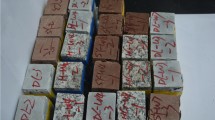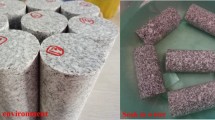Abstract
The presence of water greatly influences time-dependent rock deformation. An understanding of how water can affect the time-dependent mechanical behavior of rock is important when assessing the long-term stability of geotechnical projects. While the previous studies have performed brittle creep experiments on oven-dry or fully-saturated rocks, we report here on a study designed to better understand brittle creep at different levels of saturation. We performed brittle creep experiments on oven-dry samples of red sandstone (Hunan province, China) and samples of the sandstone pre-immersed in water for different durations (from 2 to 8 days). These samples were deformed at a constant stress in one of either two conditions: dry or submerged in water. Before performing creep experiments, we first performed a series of water absorption and constant stress rate experiments to guide the stresses required for our creep tests and to assist with their interpretation. Our creep experiments show that immersion in water greatly increased the minimum creep strain rate and greatly shortened the time-to-failure when compared to the dry state. In detail, the minimum creep strain rate and time-to-failure increased and decreased, respectively, as pre-immersion duration increased from 4 to 6 days, but did not change as the duration was further increased to 8 days. We attribute this to the saturation of microcracks between 4 and 6 days (i.e., water imbibition was complete, or close to completion, following 6 days). We also show that oven-dry samples deformed at a constant stress underwater fail at stresses much lower than oven-dry samples deformed under dry conditions, due to the imbibition of water during deformation. Samples pre-immersed in water, but deformed in the dry condition were characterized by lower strain rates and longer time-to-failure than those pre-immersed in water and deformed underwater. Our explanation for this is that, due to the availability of water, crack tips can remain hydrated when the sample is deformed underwater, thus increasing the efficacy of stress corrosion cracking. The relationships and data provided herein inform on the long-term stability of engineering structures.




















Similar content being viewed by others
References
Atkinson BK (1984) Subcritical crack growth in geological materials. J Geophys Res 89:4077–4114
Atkinson BK, Meredith PG (1987) The theory of subcritical crack growth with applications to minerals and rocks. Fract Mech Rock 2:111–166
Baud P, Meredith PG (1997) Damage accumulation during triaxial creep of Darley Dale sandstone from pore volumometry and acoustic emission. Int J Rock Mech Min Sci 34:24. e21-24. e10
Baud P, Zhu W, Wong TF (2000) Failure mode and weakening effect of water on sandstone. J Geophys Res 105:16371–16389
Brantut N, Heap MJ, Meredith PG, Baud P (2013) Time-dependent cracking and brittle creep in crustal rocks: a review. J Struct Geol 52:17–43
Brantut N, Heap MJ, Baud P, Meredith PG (2014a) Rate-and strain-dependent brittle deformation of rocks. J Geophys Res 119:1818–1836
Brantut N, Heap MJ, Baud P, Meredith PG (2014b) Mechanisms of time-dependent deformation in porous limestone. J Geophys Res 119:5444–5463
Çobanoğlu İ, Çelik SB, Dinçer İ, Alkaya D (2009) Core size and time effects on water absorption values of rock and cement mortar samples. Bull Eng Geol Env 68:483
Cruden DM, Masoumzadeh S (1987) Accelerating creep of the slopes of a coal mine. Rock Mech Rock Eng 20:123–135
David C, Menéndez B, Mengus JM (2011) X-ray imaging of water motion during capillary imbibition: Geometry and kinetics of water front in intact and damaged porous rocks. J Geophys Res 116:1–15
Dawson PR, Munson DE (1983) Numerical simulation of creep deformations around a room in a deep potash mine. Int J Rock Mech Min Geom Abs 20:33–42
Duda M, Renner J (2013) The weakening effect of water on the brittle failure strength of sandstone. Geophys J Int 192:1091–1108
Dyke CG, Dobereiner L (1991) Evaluating the strength and deformability of sandstones. Q J Eng Geol Hydroge, 24:123–134
Fujii Y, Kiyama T, Ishijima Y, Kodama J (1999) Circumferential strain behavior during creep tests of brittle rocks. Int J Rock Mech Min Sci 36:323–337
Hawkins AB, McConnell BJ (1992) Sensitivity of sandstone strength and deformability to changes in moisture content. Q J Eng Geol Hydroge 25:115–130
Heap MJ, Baud P, Meredith PG, Bell AF, Main IG (2009a) Time-dependent brittle creep in Darley Dale sandstone. J Geophys Res 114:1–22
Heap MJ, Baud P, Meredith PG (2009b) Influence of temperature on brittle creep in sandstones. Geophys Res Lett 36
Heap MJ, Baud P, Meredith PG, Vinciguerra S, Bell AF, Main IG (2011) Brittle creep in basalt and its application to time-dependent volcano deformation. Earth Planet Sc Lett 307:71–82
Heap MJ, Brantut N, Baud P, Meredith PG (2015) Time-dependent compaction band formation in sandstone. J Geophys Res 120:4808–4830
Heap MJ, Kushnir ARL, Gilg HA, Wadsworth FB, Reuschlé T, Baud P (2017) Microstructural and petrophysical properties of the Permo-Triassic sandstones (Buntsandstein) from the Soultz-sous-Forêts geothermal site (France). Geothermal Energy 5:26
King MS (1973) Creep in model pillars of saskatchewan potash. Int J Rock Mech Min Geom Abs 10:363–371
Kranz RL, Scholz CH (1977) Critical dilatant volume of rocks at the onset of tertiary creep. J Geophys Res 82:4893–4898
Kranz RL, Harris WJ, Carter NL (1982) Static fatigue of granite at 200 °C. Geophys Res Lett 9:1–4
Liu X, Yang C, Yu J (2015) The influence of moisture content on the time-dependent characteristics of rock material and its application to the construction of a tunnel portal. Adv Mater Sci Eng 2015:13
Lockner D (1993) Room temperature creep in saturated granite. J Geophys Res 98:475–487
Mallet C, Fortin J, Guéguen Y, Bouyer F (2015) Role of the pore fluid in crack propagation in glass. Mech Time Dep Mater 19:117–133
Masuda K (2001) Effects of water on rock strength in a brittle regime. J Struct Geol 23:1653–1657
Nara Y, Morimoto K, Yoneda T, Hiroyoshi N, Kaneko K (2011) Effects of humidity and temperature on subcritical crack growth in sandstone. Int J Solids Struct 48:1130–1140
Nara Y, Morimoto K, Hiroyoshi N, Yoneda T, Kaneko K, Benson PM (2012) Influence of relative humidity on fracture toughness of rock: implications for subcritical crack growth. Int J Solids Struct 49:2471–2481
Nara Y, Yamanaka H, Oe Y, Kaneko K (2013) Influence of temperature and water on subcritical crack growth parameters and long-term strength for igneous rocks. Geophys J Int 193:47–60
Ngwenya BT, Main IG, Elphick SC, Crawford BR, Smart BG (2001) A constitutive law for low-temperature creep of water-saturated sandstones. J Geophys Res 106:21811–21826
Nicolas A, Fortin J, Regnet JB, Verberne BA, Plümper O, Dimanov A, Spiers CJ, Guéguen Y (2017) Brittle and semibrittle creep of tavel limestone deformed at room temperature. J Geophys Res 122:4436–4459
Obert L (1965) Creep in model pillars. [Salt, trona, and potash ore] Bureau of Mines ED, College Park, 29
Paterson MS, Wong TF (2005) Experimental rock deformation-the brittle field. Springer Science & Business Media, Berlin
Phienwej N, Thakur PK, Cording EJ (2007) Time-dependent response of tunnels considering creep effect. Int J Geomech 7:296–306
Rehbinder PA, Schreiner LA, Zhigach KF (1948) Hardness reducers in drilling (translated from Russian). Council of Scientific and Industrial Research, Melbourne, p 163
Reviron N, Reuschlé T, Bernard JD (2009) The brittle deformation regime of water-saturated siliceous sandstones. Geophys J Int 178:1766–1778
Reynolds TD, Gloyna EF (1961) Creep Measurements in Salt Mines. The 4th US Symposium on Rock Mechanics (USRMS). University Park, Pennsylvania, American Rock Mechanics Association
Rybacki E, Herrmann J, Wirth R, Dresen G (2017) Creep of posidonia shale at elevated pressure and temperature. Rock Mech Rock Eng 50:3121–3140
Schmitt L, Forsans T, Santarelli FJ (1994) Shale testing and capillary phenomena. Int J Rock Mech Min Geom Abs 31:411–427
Shakoor A, Barefield EH (2009) Relationship between unconfined compressive strength and degree of saturation for selected sandstones. Environ Eng Geosci 15:29–40
Sone H, Zoback MD (2014) Time-dependent deformation of shale gas reservoir rocks and its long-term effect on the in situ state of stress. Int J Rock Mech Min Sci 69:120–132
Tang S, Yu C, Tang C (2018) Numerical modeling of the time-dependent development of the damage zone around a tunnel under high humidity conditions. Tunn Undergr Sp Tech 76:48–63
Wang S (1981) On the mechanism and process of slope deformation in an open pit mine. Rock Mech 13:145–156
Waza T, Kurita K, Mizutani H (1980) The effect of water on the subcritical crack growth in silicate rocks. Tectonophysics 67:25–34
Wong LNY, Jong MC (2014) Water saturation effects on the Brazilian tensile strength of gypsum and assessment of cracking processes using high-speed video. Rock Mech Rock Eng 47:1103–1115
Ye G, Nishimura T, Zhang F (2015) Experimental study on shear and creep behaviour of green tuff at high temperatures. Int J Rock Mech Min Sci 79:19–28
Zhou Z, Cai X, Cao W, Li X, Xiong C (2016) Influence of water content on mechanical properties of rock in both saturation and drying processes. Rock Mech Rock Eng 49:3009–3025
Acknowledgements
This project was financially supported by the National Basic Research Program of China (973 Program) (2014CB047100), the National Natural Science Foundation of China (51474046, U1562103), and the Fundamental Research Funds for the Central Universities (DUT17LK35). The authors additionally thank a Partenariats Hubert Curien (PHC) Cai Yuanpei grant (Grant Number 36605ZB). We also knowledge the constructive comments of two anonymous reviewers.
Author information
Authors and Affiliations
Corresponding author
Additional information
Publisher’s Note
Springer Nature remains neutral with regard to jurisdictional claims in published maps and institutional affiliations.
Rights and permissions
About this article
Cite this article
Tang, S.B., Yu, C.Y., Heap, M.J. et al. The Influence of Water Saturation on the Short- and Long-Term Mechanical Behavior of Red Sandstone. Rock Mech Rock Eng 51, 2669–2687 (2018). https://doi.org/10.1007/s00603-018-1492-3
Received:
Accepted:
Published:
Issue Date:
DOI: https://doi.org/10.1007/s00603-018-1492-3




